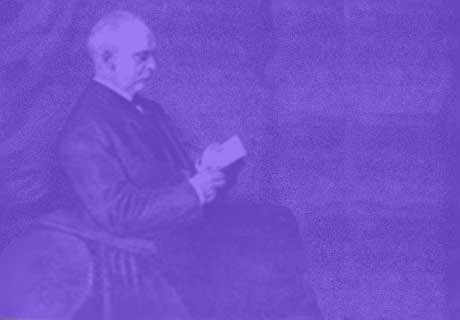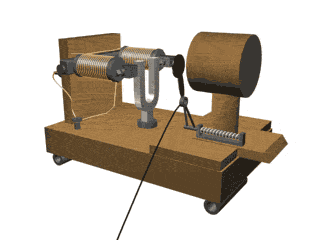


Herman Ludwig Ferdinand Helmholtz
The extrordinary scientist Herman Helmholtz made important contributions
in all major fields of science. Not only did he unify the divers
fields of medicine, physiology, anatomy, and physics, but Helmholtz
also related this universal view to the fine arts. In fact , his
first academic position was teacher of anatomy at the Academy
for fine Arts in berlin.
Born in Potsdam in August 31 1821, his youth was marred with illness.
At the age of nine he entered the Gymnasium in Potsdam where his
father was a teacher. In spite of difficulty in distiguishing
right from left., he progressed rapidly.
With a keen interest in natural science and a desire to study
physics, helmholtz was awaeded a scholorsfip to the Frederich-wilhelm
Institute in Berlin. The scholorship was awarrded under the agreement
that when he completed his studies, he would serve several years
as a military physiscian. It was here that he studied with a great
teacher and scientist, Johannes Muller. This relationship had
a tremendous influence on the young Helmholtz and with Muller
as an example and adviser, shaped his future. In 1842 helmholtz
received his doctorate for the discovery in the field of anatomy.
With his work completed at the institute, he began to fulfill
his obligation as a military surgeon. During this post, he sets
his mind on one of the nagging problems of the day, the priciple
of the conservation of energy. Describing his work at a lecture
for the Physical society of berlin in 1847, he establishes the
conservation law in its full generality. With this accomplishment
he gains the attention of the scientific commity and with the
publication of this paper, helmholtz is able to reliquish his
position as a military physician.
As mention earlier, 1848 brings us to the beginning of his academic
carrier. Helmholtz remains at the academy for just one year before
he is transferred to konigsberg. Here he is an associate professor
of physiology. He works here between 1849 and 1855 and during
this period there are two major accomplisments. The first, relates
to his work with the speed of a nerve impulse. Out of this work
comes the law of the rise of an electric current in an inductive
circuit. This law was named after him. The second accomplishment
is born from the work he was doing in optics, the invention of
the opthalmascope.
This invention brought more attention from the scientific community
and with this he began to travel. One of his first trips was to
England in 1853. As one of three foreign speakers, he attended
the British Association for the Advancement of Science in Hull.
Here he represented the only physiologist and presented a paper
dealing with color mixing. Perhaps more important to our inquire
was his introduction to and meeting with, Micheal Faraday. (use
a quote from H's letteres that describe this meeting, they're
in the biography.) He made attempts during this visit to meet
with Sir Charles wheatstone, but these were to no avail.
Another important relationship was Kimdled during this period.
Toward the end of his appointment Konigsberg , Helmholtz met William
Thomas (Lord kelvin), one of the foremost mathmatiical physicists
of Europe. The two were to remain friends and collegues for the
remainder of Helmholt's life.
His work in acoustics began while at Konigsberg. In 1852, while
reading the work of Challlis, he found some mathematical errors.
Correcting these errors aroused his interest in the field of acoustics,
a branch of hydrdynamics, for which he was to later create the
mathematical foundations. With his advanced work in optics and
a new developing interest in acoustics, Helmholtz , once again
moves on. In 18555 he accepts a position as full professor of
anatomy and physiology in Bonn.
It is in Bonn between 1855 and 1858 that he lays the foundation
for his book "On the sensation of Tone". There are two experimental
facts that contribute to this foundation. Although difference
tones arissing from two simple had already been discovered. Helmholtz
discovered the existance of summation tonnes and the dependence
of their presence on the simple tone. His theory, developed im
1856 shows how combination tones originate from the non-linear
responce of the eardrum or some other detector. (p3."On the Sensation
of Tone" This work was presented in a lecture in Bonn in 1857
titled, "The Physiological causes of Harmony in Music" It may
be that Philip Reiss attended this lecture. It is also this lecture
that was to form the body of his book "On the Sensation of Tone".
In 1854 Herman Hemholtz 33 years old delivers his lecture on Tone
and the human Ear in Bonn Germany. Philipp Reis age 17 also in
Germany begins his correspondence with Michael Faraday now 62
years old the head of the royal Institute of London. Charles Bourseul
writes a paper articulating the concept of the telephone. Ampere
and Del Rive are in France. Sir Charles Wheat Stone now 52 years
old, William Cook has now expanded their telegraph network throughout
England via the railway. Alexander Gahram Bell age 7 living with
his family at 13 south Charbtte St., Edinburgh spending his time
playing panio and lying among the heather on Scottish hills. Yeats
and Son Instrument makers and opticians have established themselves
at 2 Grafton St. in Dublin, Ireland. Across the pond in the US,
Heinrich Gobel an emigrated German watchmaker invents the electric
light bulb in New York City. Samuel Morse is hounding congress
for a contract for his version of the telegraph in Washington
DC. Joseph Henry is now a director at the Smithsonian in Washington
DC.
Seeking work during this industrial revolution people had moved
from the farms to populate the cities of the US and Europe. They
labored long hours for small wages in the gas lit sweatshops and
factories. Living conditions consisted of over crowed tenements
where as many as 20 people lay in an open room. This provided
the ideal conditions for tuberculosis to run ramped and claim
hundreds of thousands of victims. Poor sanitary conditions lead
to constant outbreaks of typhoid fever and cholera claiming even
more lives. Although anatomy had been intensely studied and well
documented Medicine was still breaking from the dark ages. Great
strides were being made in every area from bed side philosophy
in the hospitals of France to the way the English began to educate
its interns. Microscopic research in Germany would start to reveal
an understanding of the human cell and its role in combating disease.
These were all very encouraging steps but it would be another
40 years before medicine would begin to contain and manage major
public health issues.
Since steamboats delivered the bulk of life sustaining staples
these urban populations grew on riverbanks and canals. Technology
had not done much to improve the lives of people in 1854.
The steam engine raced across the railroads and telegraph wires
cover over 15,000 land miles in the US and over 20, 000 miles
in Europe with two cross continental cable connections between
Ireland and Canada and the Us and Europe. The global village was
already growing rapidly in the western world.
The individual scientist still had an ability to keep his own
automany without having to worry about an over barring corporate
structure. This allowed the individual to create with a clear
conscious and exchange ideas freely with a network of peers through
publishing in print and lecture. Experiments in Electricity and
magnetism were the subject of many articles in the scientific
pericols in both the US and Europe. So many experiments were conducted
with sound/ tone / music that the patent office had two categories
for telecommunications invention's
1)device which articulated sound, tone or music 2) device which
articulated speech. It was the lecture on "Tone" given in Bonn,
Germany by - Herman Hemholtz in 1854 and the public demonstration
given by Dr Charles Page in 1837, which seemed to have the most
dramatic impact on Music and scientific community.